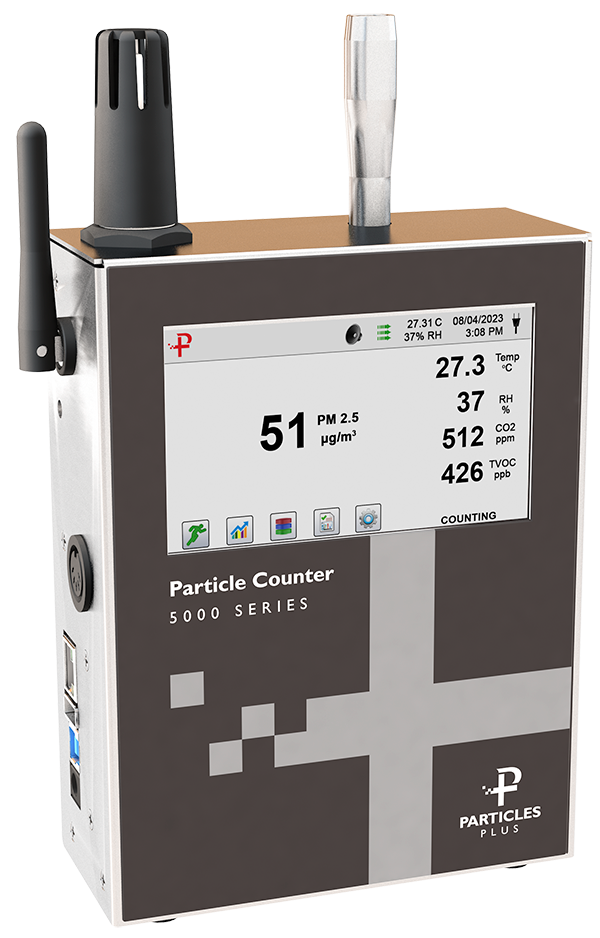Office Spaces
In a world where people spend a significant portion of their lives indoors, particularly in office environments, the quality of indoor air can have far-reaching implications. Poor indoor air quality can result in a range of health issues, including headaches, fatigue, and respiratory problems. In contrast, good indoor air quality can boost comfort, health, and productivity. As such, using advanced monitoring systems like Particles Plus indoor air quality monitors is more crucial than ever
The Effects of Poor Indoor Air Quality
The Environmental Protection Agency (EPA) lists indoor air pollution as one of the top five environmental risks to public health. Offices can harbor a range of pollutants, including Volatile Organic Compounds (VOCs) from office equipment, dust, mold spores, and allergens. In addition, outdoor pollutants such as car exhaust and particulate matter can infiltrate buildings, further degrading indoor air quality.
Poor indoor air quality can lead to an array of health problems, both immediate and long-term. Short-term exposure can cause headaches, dizziness, fatigue, and eye, nose, or throat irritation. Over time, the consequences can be more severe, potentially leading to respiratory diseases, heart disease, or even cancer.
Moreover, poor indoor air quality can significantly affect employee productivity. A study by Harvard University and Syracuse University found that people working in environments with better indoor air quality showed cognitive function scores that were 101% higher than those in conventional working environments.
The Role of Particles Plus Indoor Air Quality Monitors
In this context, Particles Plus Indoor Air Quality Monitors play a crucial role. These devices provide real-time data on a range of air quality parameters, including particulate matter, temperature, relative humidity, carbon dioxide, and VOCs. They also offer advanced features like data logging and remote access, making them an ideal choice for office environments.
By providing continuous, accurate air quality data, these monitors help building managers and occupants understand their environment better. This data can guide decision-making around HVAC system operation, cleaning schedules, and even office layout to reduce pollutant sources.
Boosting Productivity through Improved Indoor Air Quality
When indoor air quality is maintained at optimal levels, the benefits are manifold. First and foremost, it reduces the risk of health problems among employees. This, in turn, can lead to fewer sick days and lower healthcare costs.
Beyond health, good indoor air quality can have a direct impact on productivity. When the air is clean and fresh, employees are less likely to suffer from fatigue, headaches, and other symptoms associated with poor indoor air quality. They can concentrate better, think more clearly, and ultimately perform their jobs more effectively.
The use of Particles Plus Indoor Air Quality Monitors allows for proactive management of indoor environments. Instead of waiting for problems to arise, building managers can address potential issues before they impact the occupants negatively. This proactive approach not only ensures a healthier environment but also contributes to a more productive and satisfied workforce.
Monitoring and maintaining indoor air quality in offices is of paramount importance. The use of advanced monitoring systems like Particles Plus Indoor Air Quality Monitors can help achieve this goal, leading to healthier, more comfortable, and more productive working environments. As we continue to understand the profound impact of our environment on our well-being and productivity, it’s clear that investments in indoor air quality are investments in our most valuable asset – our people.
Particles Plus Instruments for Office Space Monitoring
Indoor Air Quality Monitors
Particles Plus® air quality monitors are designed to provide accurate and real-time data on indoor air quality. These monitors offer a range of features and capabilities to ensure reliable measurements. Particles Plus monitors can measure various parameters related to air quality, including particle size channels, carbon dioxide (CO2) levels, total volatile organic compounds (TVOC) temperature, and relative humidity.
